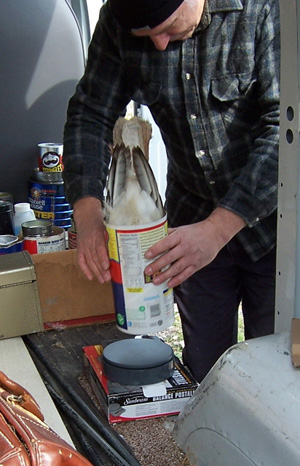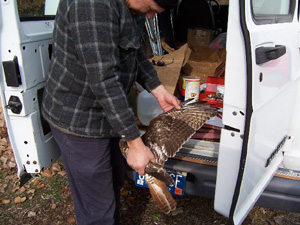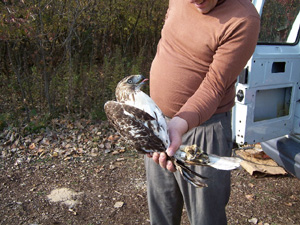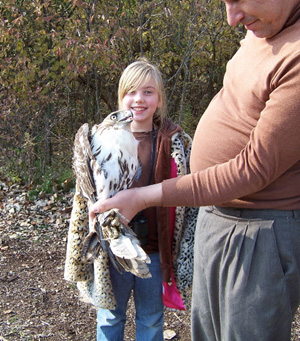

Banding Raptors at the Nature Area
by Meredith Perry The Grosse Ile Nature and Land Conservancy (GINLC) has helped support raptor banding in the Grosse Ile Nature Area since 2004.
Raptor banding is a process in which hawks are captured, banded, and weighed in order to obtain information on the health of ecosystems. Raptors are high on the food chain, and thus the health of their population is indicative of the overall state of an ecosystem. Monitoring raptor populations is important for the conservation of the many plants and animals within an ecosystem.
Thomas Carpenter, Ph.D. and Arthur Carpenter have been banding hawks in the Great Lakes area since 1981. Most northern raptor populations are migratory. Therefore, their populations can most easily be studied through counting and banding in areas that concentrate migrant birds. Monitoring raptors during this time is crucial for the preservation and protection of their populations and the ecosystems they dominate.
The shorelines of the Great Lakes concentrate migrant raptors during fall and spring migration because most hawks avoid crossing large bodies of water. Thomas and Arthur have banded raptors during fall migration along the northwest and west shores of Lake Erie and the southern Detroit River, at Point Mouillee State Game Area, Lake Erie Metropark, and the Grosse Ile Nature Area in Michigan and Holiday Beach in Ontario.
Raptor banding enables researchers to determine the age and sex composition of migrant raptors, patterns of migration of the different age and sex groups, longevity and the causes of death of migrant raptors, migration routes of raptors, and the breeding and wintering areas of migrant raptors.
In addition to establishing this information, Thomas and Arthur also have goals of determining changes in eye color, weight, and feather wear through recapturing already banded raptors and determining the rate of migration of raptors by recapturing hawks on Grosse Ile that were originally banded along the north shore of Lake Erie earlier in migration. The information obtained from these goals aids in the overall conservation of each hawk species.
Raptor banding is an eco- and animal-friendly process. Thomas and Arthur wait in a clearing over which hawks frequently pass, concealed from sight behind a blind. They have several lure birds outside of the blind that are enclosed in a specially designed leather harness that is attached to a lure line. Upon sighting a hawk, the men pull the lure line which elevates the lure bird, causing it to fly. The flying bird attracts the hawk, causing it to approach. The lure birds are protected by two to three mist nets that capture hawks when they swoop down trying to catch their prey, thereby keeping the lures from harm.
When a hawk is attracted to one of the birds in the clearing and dives to catch its prey, it gets caught in the barely-visible mist netting surrounding the lure field. The men immediately remove the hawk from the netting, place it in a can (the can restrains the hawk without harming it), and proceed to band, weigh, and measure it. Eye color and other noteworthy characteristics are recorded. The raptor is released unharmed within 10 minutes.
Since 2004, one Red-shouldered Hawk, two American Kestrels, two Northern Harriers, 11 Sharp-shinned Hawks, 13 Cooper's Hawks, and 44 Red-tailed Hawks have been banded. Overall at this site, the Carpenters have banded and recorded valuable information about 73 hawks during the time period, a significant number that will enhance future research.
The GINLC will continue to aid Thomas and Arthur in their quest by helping to prepare banding site and providing access to the Grosse Ile Nature Area, increasing the chance for conservation of important raptor species.
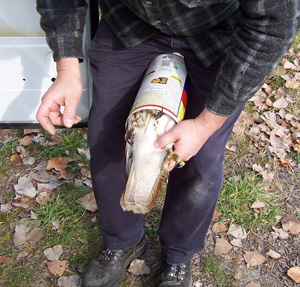
A Red-tailed hawk is secured in a can for banding. The other end of the can has breathing holes.
Tom Carpenter is weighing the bird.
The bird's wing is inspected and measured.
The banded hawk adjusts before release.
A different Red-tailed hawk after banding. Note the band on one of its legs.
Olivia Robinson, 3rd grader from Parke Lane Elementary school, has been watching the banding procedure with her grandmother, Margarete Hasserodt.Photos by Margarete Hasserodt
